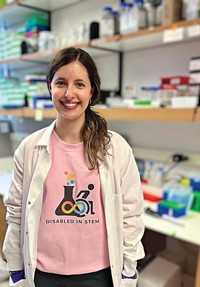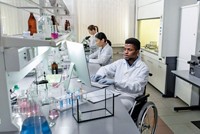Advertisement
Grab your lab coat. Let's get started
Welcome!
Welcome!
Create an account below to get 6 C&EN articles per month, receive newsletters and more - all free.
It seems this is your first time logging in online. Please enter the following information to continue.
As an ACS member you automatically get access to this site. All we need is few more details to create your reading experience.
Not you? Sign in with a different account.
Not you? Sign in with a different account.
ERROR 1
ERROR 1
ERROR 2
ERROR 2
ERROR 2
ERROR 2
ERROR 2
Password and Confirm password must match.
If you have an ACS member number, please enter it here so we can link this account to your membership. (optional)
ERROR 2
ACS values your privacy. By submitting your information, you are gaining access to C&EN and subscribing to our weekly newsletter. We use the information you provide to make your reading experience better, and we will never sell your data to third party members.
Careers
Opening Doors For The Disabled
Workshop explores ways to better integrate people with disabilities in academia
by Rochelle F. H. Bohaty
March 16, 2009
| A version of this story appeared in
Volume 87, Issue 11

IN 1990, only a few months after joining the faculty as an assistant professor at Purdue University, Ian P. Shipsey completely lost his hearing. "It began when I could not hear the quiet passages of music on a car radio. That day, turning up the volume helped, but soon there was no more music," he recalled.
Shipsey, now the Julian Schwinger Distinguished Professor of Physics at Purdue, was one of several speakers last month at the Workshop on Excellence Empowered by a Diverse Academic Workforce: Chemists, Chemical Engineers & Materials Scientists with Disabilities, in Arlington, Va. The workshop was sponsored by the National Institutes of Health, the National Science Foundation, and the University of Kansas.
It underscored that participation of people with disabilities in academia is vital because they not only offer knowledge and talent but also bring unique skills and perspectives. To encourage them to join and stay in academia, workshop participants like Shipsey shed light on the obstacles and opportunities they face. Among the obstacles is a lack of data on the number of science, technology, engineering, and mathematics (STEM) faculty with disabilities and the types of disabilities affecting them. Among the opportunities are the growing intent of institutions to create academic environments where disabled faculty can thrive and the increasing funding options for researchers with disabilities.
Broadening participation of people with disabilities in the STEM workforce has not received as much attention as that of women and individuals from underrepresented ethnic groups, according to Thomas E. Mallouk, a workshop committee cochair and a materials chemistry and physics professor at Pennsylvania State University. "The disability issue is the one that is under the radar, but it is an issue that directly affects 16% of Americans, including many distinguished scientists. These are obviously people we can't afford to keep out of our profession," Mallouk said.
"People with disabilities not only have the same general spectrum of talents as any other group, they also add unique perspectives and often bring incredible energy and determination to the workforce" said Kathie L. Olsen, senior adviser for the Office of Information & Resource Management at NSF. For example, disabled people find ways to do things differently to overcome challenges on a daily basis, she noted. They are extremely creative people with great problem-solving skills, she added.
ALTHOUGH a number of people are born with disabilities, anyone can develop one, especially later in life. For example, Shipsey lost his hearing from taking a medically necessary dose of an autotoxic antibiotic that destroyed the hair cells in his cochlea. Disabilities can also be caused by accidents and age-related health problems such as stroke.
Age-related causes are of particular concern for STEM faculty because data show that doctoral science and engineering faculty are older than the general working population. This fact increases the likelihood that academic departments, including chemistry and chemical engineering, will have disabled faculty, said Joan Burrelli, a senior analyst for the Science & Engineering Indicators Program at NSF.
Putting exact numbers on just how many people in STEM fields are disabled is difficult. Although NSF compiles data on STEM demographics such as age, gender, and ethnicity, data on people with disabilities are "fairly sparse" and have been recorded only for a short time, Burrelli pointed out. According to the data NSF has collected, approximately 5% of scientists and engineers have disabilities, compared with about 16% of the population, she reported.
But NSF's data may not accurately reflect reality and could be misleading, Burrelli cautioned, because they rely primarily on self-reporting. The issue is also complicated by differences in disability classifications and reporting methods used by government agencies and academic institutions.
ONE WAY to improve the data is for all grant applicants to disclose disabilities in application materials, NSF officials suggested. This information is kept confidential and is not provided to reviewers. It is used only for compiling statistics, noted Celeste Rohlfing, head of the Office of Multidisciplinary Activities at NSF.
Another topic of interest at the workshop was hidden disabilities such as depression and anxiety. Mental health diseases "are the most invisible of disabilities," said Victor W. Day, a crystallographer at the University of Kansas who copes with bipolar disorder. Many people don't even know that they have a problem, he said.
Often, it can take 10 to 15 years after symptoms appear before the problem is diagnosed, he added. The median age for the onset of major depressive disorders is 32, according to Day. This is a particularly important statistic for academics because it coincides with the stressful pretenure period, which can have a significant impact on people with mental health disabilities, he said.
Creating an environment where those with diagnosed mental disabilities can openly talk about disorders is important, Day said. It might prevent tragedies, he told the crowd at the workshop, citing as an example the suicide last year of an assistant chemistry professor at the University of Kansas who suffered from major depression.
Only one person in the chemistry department of the University of Kansas knew of the assistant professor's depression, Day noted, and he believes that had more people been aware, something could have been done to prevent the tragedy.
For this reason, Day and his colleagues encourage department chairs to talk about mental health concerns, along with other types of disabilities, with their faculty. "It's important to get people to talk about disabilities they have that might affect their careers," said David R. Benson, a workshop committee cochair and chemistry professor at the University of Kansas. Having an open line of communication will help, he added.
Because approaching people with disabilities, particularly mental disabilities, can be daunting and can also have legal implications, Virginia J. Reilly, director of University Americans with Disabilities Act (ADA) Services at Virginia Polytechnic Institute & State University, suggested that department chairs engage their institutions' ADA services.
Signed into law in 1990, ADA prohibits private employers, state and local governments, employment agencies, and labor unions from discriminating against individuals with disabilities. These organizations must also make reasonable accommodations for disabled people.
One way to bring disability concerns to the forefront of discussion is to include ADA representatives in faculty meetings and ask them to give presentations, Reilly said. These discussions will help faculty learn about the wide array of disabilities, potential accommodations, and available resources. They can help create an environment that is more sensitive toward people with disabilities and make managing easier when faculty encounter problems, such as missing lectures or not producing enough results, because of their disability, she noted.
Another hot topic at the workshop was the idea of universal design, a tool that Sheryl Burgstahler, a professor of education at the University of Washington, discussed. Burgstahler is also the director of the DO-IT (Disabilities, Opportunities, Internetworking & Technology) Center at Washington. This NSF-funded center aims to increase the participation of individuals with disabilities in challenging academic programs and careers.
Universal design is a broad-spectrum approach for increasing accessibility that benefits everyone, not just people with disabilities, Burgstahler said. It can be applied to activities as dissimilar as constructing a building, constructing a curriculum, and mentoring, Burgstahler added. Examples participants discussed during the workshop include increasing flexibility of the tenure clock and sabbaticals; offering a combination of written, oral, and practical exams; and developing contingency plans for unexpected leave.
THE PRINCIPLES of universal design would also increase the accessibility of chemistry labs to disabled people. William C. McCarthy, a professor of civil engineering at New Mexico State University, suggested that labs be equipped with adjustable tables, walk-in hoods, plastic labware, and caps for bottles and flasks. He also suggested limiting combination locks, obstructions, knobs, and clutter.
Safety features must also be more readily available, McCarthy said. For example, the activation handle for safety showers are often too high for someone like McCarthy, who is in a wheelchair, as are eyewash stations. He suggested solutions such as tying a rope with several knots to shower activation handles and purchasing eyewash stations that have a pullout spray nozzle.
Incorporating elements of universal design will minimize the accommodations institutions need to provide and will also make for a more welcoming and inclusive environment for everyone, Burgstahler explained.
Lots of fixes are low cost, but some modifications are expensive, such as lab remodeling and assistive technologies, including computers and computer software, McCarthy acknowledged. Faculty should look into federally funded grant opportunities to support these efforts, he suggested.
Government officials discussed such funding options available to researchers with disabilities. They include support not only for disabled principal investigators but also for undergraduate, graduate, and postdoctoral researchers and senior project personnel who are disabled.
An example is NSF's Facilitation Awards for Scientists & Engineers with Disabilities, a program that provides supplemental funding for special equipment and assistance for people with disabilities who are supported by NSF. It is designed to encourage disabled individuals to pursue careers in STEM, said NSF's Rohlfing. Applications for this supplemental funding can be part of a competitive proposal submission or a supplement to existing NSF grants, she noted. Other organizations, including NIH, offer similar awards.
At the end of the three-day workshop, participants left determined to share what they learned with their colleagues and to find ways to include people with disabilities in their own departments. "We need to work harder to remove barriers," NSF's Olsen said. "This needs to be done not out of charity but to build the best possible workforce."






Join the conversation
Contact the reporter
Submit a Letter to the Editor for publication
Engage with us on Twitter